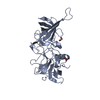[English] 日本語
 Yorodumi
Yorodumi- EMDB-20202: Asymmetric focsued reconstruction of human norovirus GII.2 Snow M... -
+ Open data
Open data
- Basic information
Basic information
| Entry | Database: EMDB / ID: EMD-20202 | |||||||||
|---|---|---|---|---|---|---|---|---|---|---|
| Title | Asymmetric focsued reconstruction of human norovirus GII.2 Snow Mountain Virus strain VLP asymmetric unit in T=1 symmetry | |||||||||
 Map data Map data | Asymmetric focused reconstruction of human norovirus GII.2 Snow Mountain Virus strain VLP asymmetric unit in T=1 symmetry | |||||||||
 Sample Sample |
| |||||||||
 Keywords Keywords | Caliciviridae / Norovirus / GII.2 / Snow Mountain Virus / VIRUS LIKE PARTICLE | |||||||||
| Function / homology | Calicivirus coat protein C-terminal / Calicivirus coat protein C-terminal / Calicivirus coat protein / Calicivirus coat protein / Picornavirus/Calicivirus coat protein / Viral coat protein subunit / Viral protein 1 Function and homology information Function and homology information | |||||||||
| Biological species |  Snow Mountain virus Snow Mountain virus | |||||||||
| Method | single particle reconstruction / cryo EM / Resolution: 2.8 Å | |||||||||
 Authors Authors | Jung J / Grant T | |||||||||
| Funding support |  United States, 1 items United States, 1 items
| |||||||||
 Citation Citation |  Journal: Proc Natl Acad Sci U S A / Year: 2019 Journal: Proc Natl Acad Sci U S A / Year: 2019Title: High-resolution cryo-EM structures of outbreak strain human norovirus shells reveal size variations. Authors: James Jung / Timothy Grant / Dennis R Thomas / Chris W Diehnelt / Nikolaus Grigorieff / Leemor Joshua-Tor /  Abstract: Noroviruses are a leading cause of foodborne illnesses worldwide. Although GII.4 strains have been responsible for most norovirus outbreaks, the assembled virus shell structures have been available ...Noroviruses are a leading cause of foodborne illnesses worldwide. Although GII.4 strains have been responsible for most norovirus outbreaks, the assembled virus shell structures have been available in detail for only a single strain (GI.1). We present high-resolution (2.6- to 4.1-Å) cryoelectron microscopy (cryo-EM) structures of GII.4, GII.2, GI.7, and GI.1 human norovirus outbreak strain virus-like particles (VLPs). Although norovirus VLPs have been thought to exist in a single-sized assembly, our structures reveal polymorphism between and within genogroups, with small, medium, and large particle sizes observed. Using asymmetric reconstruction, we were able to resolve a Zn metal ion adjacent to the coreceptor binding site, which affected the structural stability of the shell. Our structures serve as valuable templates for facilitating vaccine formulations. | |||||||||
| History |
|
- Structure visualization
Structure visualization
| Movie |
 Movie viewer Movie viewer |
|---|---|
| Structure viewer | EM map:  SurfView SurfView Molmil Molmil Jmol/JSmol Jmol/JSmol |
| Supplemental images |
- Downloads & links
Downloads & links
-EMDB archive
| Map data |  emd_20202.map.gz emd_20202.map.gz | 365.3 KB |  EMDB map data format EMDB map data format | |
|---|---|---|---|---|
| Header (meta data) |  emd-20202-v30.xml emd-20202-v30.xml emd-20202.xml emd-20202.xml | 16.2 KB 16.2 KB | Display Display |  EMDB header EMDB header |
| FSC (resolution estimation) |  emd_20202_fsc.xml emd_20202_fsc.xml | 9.8 KB | Display |  FSC data file FSC data file |
| Images |  emd_20202.png emd_20202.png | 138 KB | ||
| Filedesc metadata |  emd-20202.cif.gz emd-20202.cif.gz | 6.4 KB | ||
| Archive directory |  http://ftp.pdbj.org/pub/emdb/structures/EMD-20202 http://ftp.pdbj.org/pub/emdb/structures/EMD-20202 ftp://ftp.pdbj.org/pub/emdb/structures/EMD-20202 ftp://ftp.pdbj.org/pub/emdb/structures/EMD-20202 | HTTPS FTP |
-Validation report
| Summary document |  emd_20202_validation.pdf.gz emd_20202_validation.pdf.gz | 361.4 KB | Display |  EMDB validaton report EMDB validaton report |
|---|---|---|---|---|
| Full document |  emd_20202_full_validation.pdf.gz emd_20202_full_validation.pdf.gz | 361 KB | Display | |
| Data in XML |  emd_20202_validation.xml.gz emd_20202_validation.xml.gz | 8.6 KB | Display | |
| Data in CIF |  emd_20202_validation.cif.gz emd_20202_validation.cif.gz | 11.6 KB | Display | |
| Arichive directory |  https://ftp.pdbj.org/pub/emdb/validation_reports/EMD-20202 https://ftp.pdbj.org/pub/emdb/validation_reports/EMD-20202 ftp://ftp.pdbj.org/pub/emdb/validation_reports/EMD-20202 ftp://ftp.pdbj.org/pub/emdb/validation_reports/EMD-20202 | HTTPS FTP |
-Related structure data
| Related structure data |  6oucMC  6otfC  6ou9C  6outC  6ouuC C: citing same article ( M: atomic model generated by this map |
|---|---|
| Similar structure data |
- Links
Links
| EMDB pages |  EMDB (EBI/PDBe) / EMDB (EBI/PDBe) /  EMDataResource EMDataResource |
|---|---|
| Related items in Molecule of the Month |
- Map
Map
| File |  Download / File: emd_20202.map.gz / Format: CCP4 / Size: 10 MB / Type: IMAGE STORED AS FLOATING POINT NUMBER (4 BYTES) Download / File: emd_20202.map.gz / Format: CCP4 / Size: 10 MB / Type: IMAGE STORED AS FLOATING POINT NUMBER (4 BYTES) | ||||||||||||||||||||||||||||||||||||||||||||||||||||||||||||||||||||
|---|---|---|---|---|---|---|---|---|---|---|---|---|---|---|---|---|---|---|---|---|---|---|---|---|---|---|---|---|---|---|---|---|---|---|---|---|---|---|---|---|---|---|---|---|---|---|---|---|---|---|---|---|---|---|---|---|---|---|---|---|---|---|---|---|---|---|---|---|---|
| Annotation | Asymmetric focused reconstruction of human norovirus GII.2 Snow Mountain Virus strain VLP asymmetric unit in T=1 symmetry | ||||||||||||||||||||||||||||||||||||||||||||||||||||||||||||||||||||
| Projections & slices | Image control
Images are generated by Spider. generated in cubic-lattice coordinate | ||||||||||||||||||||||||||||||||||||||||||||||||||||||||||||||||||||
| Voxel size | X=Y=Z: 1.07 Å | ||||||||||||||||||||||||||||||||||||||||||||||||||||||||||||||||||||
| Density |
| ||||||||||||||||||||||||||||||||||||||||||||||||||||||||||||||||||||
| Symmetry | Space group: 1 | ||||||||||||||||||||||||||||||||||||||||||||||||||||||||||||||||||||
| Details | EMDB XML:
CCP4 map header:
| ||||||||||||||||||||||||||||||||||||||||||||||||||||||||||||||||||||
-Supplemental data
- Sample components
Sample components
-Entire : Snow Mountain virus
| Entire | Name:  Snow Mountain virus Snow Mountain virus |
|---|---|
| Components |
|
-Supramolecule #1: Snow Mountain virus
| Supramolecule | Name: Snow Mountain virus / type: virus / ID: 1 / Parent: 0 / Macromolecule list: #1 / NCBI-ID: 52276 / Sci species name: Snow Mountain virus / Sci species strain: GII.2 / Virus type: VIRUS-LIKE PARTICLE / Virus isolate: STRAIN / Virus enveloped: No / Virus empty: Yes |
|---|---|
| Host (natural) | Organism:  Homo sapiens (human) Homo sapiens (human) |
| Molecular weight | Theoretical: 3.56 MDa |
| Virus shell | Shell ID: 1 / Name: VP1 / Diameter: 310.0 Å / T number (triangulation number): 1 |
-Macromolecule #1: Viral protein 1
| Macromolecule | Name: Viral protein 1 / type: protein_or_peptide / ID: 1 / Number of copies: 1 / Enantiomer: LEVO |
|---|---|
| Source (natural) | Organism:  Snow Mountain virus Snow Mountain virus |
| Molecular weight | Theoretical: 59.321809 KDa |
| Recombinant expression | Organism:  |
| Sequence | String: MKMASNDAAP STDGAAGLVP ESNNEVMALE PVAGAALAAP VTGQTNIIDP WIRANFVQAP NGEFTVSPRN APGEVLLNLE LGPELNPYL AHLARMYNGY AGGMEVQVML AGNAFTAGKL VFAAVPPHFP VENLSPQQIT MFPHVIIDVR TLEPVLLPLP D VRNNFFHY ...String: MKMASNDAAP STDGAAGLVP ESNNEVMALE PVAGAALAAP VTGQTNIIDP WIRANFVQAP NGEFTVSPRN APGEVLLNLE LGPELNPYL AHLARMYNGY AGGMEVQVML AGNAFTAGKL VFAAVPPHFP VENLSPQQIT MFPHVIIDVR TLEPVLLPLP D VRNNFFHY NQKDDPKMRI VAMLYTPLRS NGSGDDVFTV SCRVLTRPSP DFDFTYLVPP TVESKTKPFT LPILTLGELS NS RFPVSID QMYTSPNEVI SVQCQNGRCT LDGELQGTTQ LQVSGICAFK GEVTAHLQDN DHLYNITITN LNGSPFDPSE DIP APLGVP DFQGRVFGVI TQRDKQNAAG QSQPANRGHD AVVPTYTAQY TPKLGQVQIG TWQTDDLKVN QPVKFTPVGL NDTE HFNQW VVPRYAGALN LNTNLAPSVA PVFPGERLLF FRSYLPLKGG YGNPAIDCLL PQEWVQHFYQ EAAPSMSEVA LVRYI NPDT GRALFEAKLH RAGFMTVSSN TSAPVVVPAN GYFRFDSWVN QFYSLAPMGT GNGRRRIQ UniProtKB: Viral protein 1 |
-Macromolecule #2: ZINC ION
| Macromolecule | Name: ZINC ION / type: ligand / ID: 2 / Number of copies: 1 / Formula: ZN |
|---|---|
| Molecular weight | Theoretical: 65.409 Da |
-Macromolecule #3: water
| Macromolecule | Name: water / type: ligand / ID: 3 / Number of copies: 124 / Formula: HOH |
|---|---|
| Molecular weight | Theoretical: 18.015 Da |
| Chemical component information |  ChemComp-HOH: |
-Experimental details
-Structure determination
| Method | cryo EM |
|---|---|
 Processing Processing | single particle reconstruction |
| Aggregation state | particle |
- Sample preparation
Sample preparation
| Concentration | 4 mg/mL |
|---|---|
| Buffer | pH: 5.75 |
| Grid | Material: COPPER / Support film - Material: CARBON / Support film - topology: LACEY / Pretreatment - Type: GLOW DISCHARGE / Details: unspecified |
| Vitrification | Cryogen name: ETHANE / Chamber humidity: 95 % / Chamber temperature: 295 K / Instrument: LEICA EM GP |
- Electron microscopy
Electron microscopy
| Microscope | FEI TITAN KRIOS |
|---|---|
| Specialist optics | Energy filter - Name: GIF Quantum LS |
| Image recording | Film or detector model: GATAN K2 SUMMIT (4k x 4k) / Detector mode: SUPER-RESOLUTION / Number real images: 2809 / Average exposure time: 7.0 sec. / Average electron dose: 69.0 e/Å2 |
| Electron beam | Acceleration voltage: 300 kV / Electron source:  FIELD EMISSION GUN FIELD EMISSION GUN |
| Electron optics | C2 aperture diameter: 70.0 µm / Illumination mode: FLOOD BEAM / Imaging mode: BRIGHT FIELD / Cs: 2.7 mm / Nominal defocus max: 2.6 µm / Nominal defocus min: 1.2 µm / Nominal magnification: 130000 |
| Sample stage | Specimen holder model: FEI TITAN KRIOS AUTOGRID HOLDER / Cooling holder cryogen: NITROGEN |
| Experimental equipment |  Model: Titan Krios / Image courtesy: FEI Company |
+ Image processing
Image processing
-Atomic model buiding 1
| Initial model | PDB ID: Chain - Chain ID: A / Chain - Residue range: 225-532 / Chain - Source name: PDB / Chain - Initial model type: experimental model |
|---|---|
| Refinement | Space: REAL / Protocol: AB INITIO MODEL |
| Output model |  PDB-6ouc: |
 Movie
Movie Controller
Controller


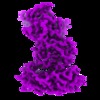










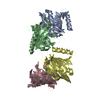
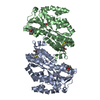
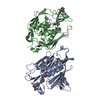



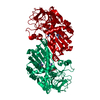
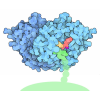
 Z (Sec.)
Z (Sec.) Y (Row.)
Y (Row.) X (Col.)
X (Col.)






















